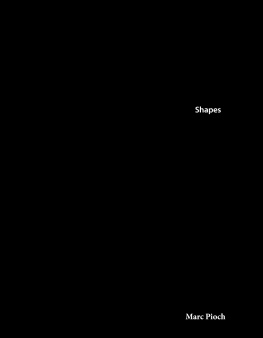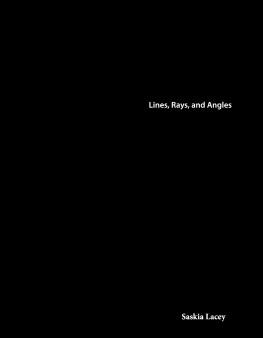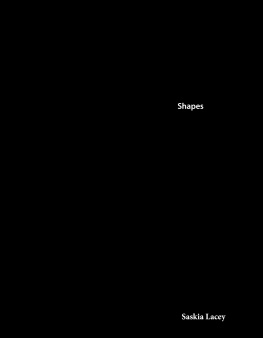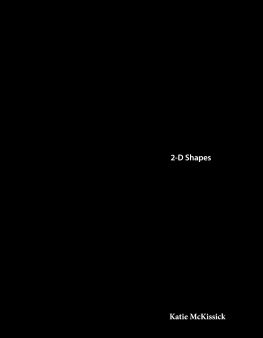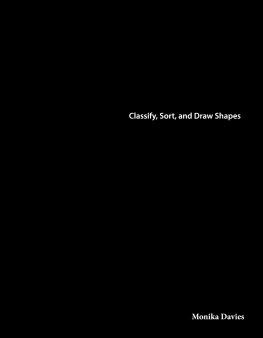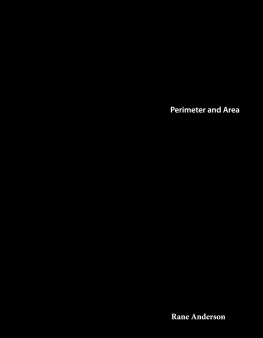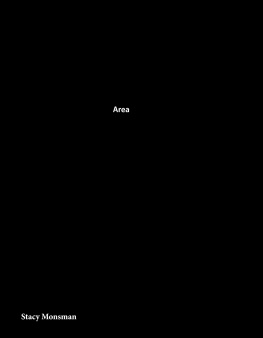Marc Pioch - Art and Culture: Exploring the Louvre: Shapes
Here you can read online Marc Pioch - Art and Culture: Exploring the Louvre: Shapes full text of the book (entire story) in english for free. Download pdf and epub, get meaning, cover and reviews about this ebook. year: 2017, publisher: Triangle Interactive, LLC, genre: Detective and thriller. Description of the work, (preface) as well as reviews are available. Best literature library LitArk.com created for fans of good reading and offers a wide selection of genres:
Romance novel
Science fiction
Adventure
Detective
Science
History
Home and family
Prose
Art
Politics
Computer
Non-fiction
Religion
Business
Children
Humor
Choose a favorite category and find really read worthwhile books. Enjoy immersion in the world of imagination, feel the emotions of the characters or learn something new for yourself, make an fascinating discovery.
- Book:Art and Culture: Exploring the Louvre: Shapes
- Author:
- Publisher:Triangle Interactive, LLC
- Genre:
- Year:2017
- Rating:5 / 5
- Favourites:Add to favourites
- Your mark:
- 100
- 1
- 2
- 3
- 4
- 5
Art and Culture: Exploring the Louvre: Shapes: summary, description and annotation
We offer to read an annotation, description, summary or preface (depends on what the author of the book "Art and Culture: Exploring the Louvre: Shapes" wrote himself). If you haven't found the necessary information about the book — write in the comments, we will try to find it.
Marc Pioch: author's other books
Who wrote Art and Culture: Exploring the Louvre: Shapes? Find out the surname, the name of the author of the book and a list of all author's works by series.
Art and Culture: Exploring the Louvre: Shapes — read online for free the complete book (whole text) full work
Below is the text of the book, divided by pages. System saving the place of the last page read, allows you to conveniently read the book "Art and Culture: Exploring the Louvre: Shapes" online for free, without having to search again every time where you left off. Put a bookmark, and you can go to the page where you finished reading at any time.
Font size:
Interval:
Bookmark:
0covercover.xhtmlArt and Culture Exploring the Louvre Shapes Marc Piochcover1page0001page0001.xhtml22page0002page0002.xhtml33page0003page0003.xhtml44page0004page0004.xhtmlTable of Contents Welcome to the Louvre 4 Visitor Experience 14 Artwork 20 Gateways to the Past and Future 27 Problem Solving 28 Glossary 30 Index 31 Answer Key 3255page0005page0005.xhtmlWelcome to the Louvre Paris, France, is known as the City of Light. It is also known as home to one of the biggest museums in the world. Visitors cant miss the Louvre (LOOV). It is a huge sixteenth-century palace on the right bank of the River Seine (SEN). It has four glass pyramids in front of it.66page0006page0006.xhtmlThe outside of the Louvre is not the only unique part. The inside awes guests, too. It is home to many well-known works of art. It takes a lot of people to keep the Louvre up and running. Its two thousand staff members share facts about the museum and its art. And, they help to take care of all the artwork. That is vital at a place like the Louvre. Over eight million guests go to the Louvre each year!77page0007page0007.xhtmlMaking of a Museum The Louvre, as we know it, has been around for over two hundred years. But, it wasnt always open to the public. And, it wasnt always a museum. In 1190, King Philip II built a fort where the Louvre would someday stand. He thought the fort would help guard Paris. Later kings used it as their Paris palace. In 1546, King Francis I tore down the fort. He thought it looked old. So, he built a new home. He called it the Louvre. Then, in 1682, King Louis XIV moved his court out of Paris. The Louvre was empty for years. But then, artists went to live and work there. In 1789, a new government, without kings and queens, came to power. They liked the art at the Louvre and added more. The new museum opened its doors four years later. It housed more than five hundred pieces of art. medieval foundations of the Louvre88page0008page0008.xhtmlThis diagram shows the evolution of the Louvre from the original fort (in red) to its current layout (in brown) with its underground expansion (in blue).99page0009page0009.xhtmlThe museum grew over the years until it became one of the biggest in the world. So, how big is big? It is bigger than 11 American football fields. And it has over seven hundred times the amount of art as it did when it opened. With so much artwork, some division can be helpful. The Louvre is divided a few ways. There are four floors. It is also split into the Old Louvre and the New Louvre. The Old Louvre gets a lot of visitors. It shows some of the most famous works of art. The New Louvre is more modern. All guests must see at least a little bit of the New Louvre. After all, thats where the main entrance is found. the Louvre in 16221010page0010page0010.xhtmlthe Louvre today let's1111page0011page0011.xhtmlThe Main Entrance The Louvre does not have a plain entrance for guests. That would be too normal for an art museum in a former palace. Instead, the large courtyard has four glass pyramids. I. M. Pei designed them in the 1980s. Pei is Chinese-American. He was the first non-French architect to work on the Louvre. The largest pyramid is the entrance. Pei made it over 70 feet (21 meters) tall. Thats about as tall as 7 elephants stacked on top of each other! It is made of glass shapes that are joined by steel poles. There are 603 rhombuses and 70 triangles. the famous pyramid entrance in the courtyard at the Louvre1212page0012page0012.xhtmlGuests cannot miss the beauty of this entrance. During the day, the glass shines brightly from the sun. At night, it lights up like diamonds. At any time of day or night, the pyramids are works of art. Let's1313page0013page0013.xhtmlVisitors to the Louvre admire the artwork in the Grande Galerie.1414page0014page0014.xhtmlClassic Flooring All guests enter through the New Louvre. But soon they find themselves walking on one of its oldest parts the floor of the Grande Galerie. The floor in this room is made of parquet. Parquet flooring is different from other floors. It uses small pieces of wood to form patterns. The floor is very easy to clean. It just needs to be swept every other day. It does not stain easily. Anything that is spilled can be wiped off. If it ever gets scratched, it only needs to be sanded. But why does the parquet flooring get so much attention from guests? What could be so special about an old floor? It is famous for its design. The Louvre was the first to have parquet flooring with this certain design. So many people loved the pattern that it was named after the museum. Flooring is sold that looks just like it. For that reason, the floor in the Grande Galerie is a work of art. Let's1515page0015page0015.xhtmlVisitor Experience Visitors to the Louvre must choose where they want to start their tours. Most guests take a free map in the lobby. The maps come in 13 languages. So, there is a good chance guests will find the one they need. Maps are not the only way to find your way around the Louvre. Audio guides are an option, too. Guests can download or rent audio guides that share facts about the Louvre and its artwork. Some guests like to listen to a live person instead of a recording. So, they turn to staff-guided tours. The Masterpieces tour is the most popular. It shows some of the Louvres most famous works of art.1616page0016page0016.xhtmlThis painting, showing the coronation ceremony of Napoleon I, is a part of The Masterpieces tour at the Louvre. Visitors to the Louvre listen to audio guides as they look at artwork.1717page0017page0017.xhtmlWhether guests choose to explore on their own or with a guide, most want to see the art up close. But, the art is priceless and fragile. Some works are thousands of years old! If they are touched, they will be ruined. A visually impared woman runs her hands over a statue in the Tactile Gallery.1818page0018page0018.xhtmlThe staff at the Louvre wants guests to have a complete experience. So, they built the Tactile Gallery. Here, guests can touch casts of 20 sculptures. This way, they can look and touch without damaging the real art. Authentic materials like bronze and stone were used to recreate the works of art. The casts look and feel the same as the real pieces. Let's1919page0019page0019.xhtmlArtsy Appetites Exploring a huge museum can really make you hungry! Luckily, the Louvre has 15 places to eat. One caf is set right below the pyramid. Others are spread throughout the museum. A few are outdoors in the gardens. Some sell quick snacks. Others serve full meals. And some only serve desserts! France is known for its desserts. One caf sells tasty crepes. A crepe is like a thin pancake. It can be a meal when filled with things like ham and cheese. Or, it can be packed with sweets like chocolate and strawberries. Many guests love to eat their crepes on the patios in the heart of the Louvres gardens. From sit-down meals to delicious desserts, the Louvre has something for everyone. crepes with berries2020page0020page0020.xhtmlLet's2121page0021page0021.xhtmlArtwork Of course, there is more to see at the Louvre than just the food! The main draw of the Louvre is the artwork. Mona Lisa The Mona Lisa is a must-see. Leonardo da Vinci painted the portrait in the early 1500s. It was moved to the Louvre in 1797. Many guests are shocked when they see how small it is. But the size is not the only thing that has guests talking. Most people are not sure whether she is smiling. Visitors to the Louvre wait for hours for a chance to see the Mona Lisa up close.2222page0022page0022.xhtmlThe Mona Lisa is priceless. It has thick glass in front of it. And two guards are on watch at all times. It has only left the Louvre a few times. The first was when an emperor wanted it hung in his house. It has also been loaned to other museums. Once, it left the Louvre illegally! It was stolen in 1911, but was found and returned two years later.2323page0023page0023.xhtmlThe Winged Victory of Samothrace Famous artists, like da Vinci, did not create all of the art in the Louvre. Some names have been lost to time. The Louvre staff is not sure who carved the Winged Victory of Samothrace. But they do know it is over two thousand years old! The 18-ft. (5-m) tall sculpture used to be in Greece. Scholars think it was carved to thank the Greek goddess Victory. When it was found in the 1860s, the feet, arms, and head were gone. Even so, it is still a work of genius. Victory and her long, flowing gown were carved out of marble. The sculptor used huge blocks to carve the statue piece by piece. Then, all the parts were assembled. It may have taken years to finish. Let's2424page0024page0024.xhtmlthe Winged Victory of Samothrace2525page0025page0025.xhtmlWhat Else Can Be Art? When most people think of art, they think of paintings and sculptures. And the Louvre has plenty of those. But artwork can be more than just paintings and sculptures. The Louvre has rare jewelry, too. Pendants, cuffs, earrings, and rings from the past are all on display. Some are solid gold. Others have big diamonds. The Louvre even has some of the crown jewels of France. The Louvre has furniture, rugs, glass, and ceramics for guests to see, too. But there arent just dusty old couches. There are huge thrones and delicate chairs. There are even giant beds that take up entire rooms! These are all on display at the museum. Visitors to the Louvre admire the French Crown Jewels.2626page0026page0026.xhtmlSome of the most extravagant pieces at the museum are furniture.2727page0027page0027.xhtmlSculptor Tony Cragg stands in front of his statue Versus at the Louvre.2828page0028page0028.xhtmlGateways to the Past and Future The Louvre may seem like it only offers a glimpse of the past. But the Louvre has been home to some newer pieces, too. Tony Cragg, a modern sculptor, had his work shown at the museum in 2011. The Louvre also has new branches in Lens and Abu Dhabi. They allow more guests to see what the Louvre has to offer. Can you offer something unique to the Louvre? If thats the case, you may wish to be more than just a guest. What is your artistic style? Do you like to draw, paint, or sculpt? Do you take photographs or make jewelry? Keep creating. One day, millions of people may see your artwork at the world-famous Louvre! Louvre Abu Dhabi under construction2929page0029page0029.xhtmlProblem Solving The famous glass pyramid at the Louvre was built because the old entrance was not big enough for all of the guests. At first, some people did not like the pyramid. They thought it looked too modern. But, the pyramid has become a key part of the Louvre. Since it is such an important landmark, the museum wants to be sure that the glass always gleams. Each triangular face of the pyramid is made of hundreds of glass shapes, and each one needs to be cleaned. Now, this job is handled by remote controlled robots. But, cleaning used to be done by people who climbed the sides of the pyramids. Imagine that window cleaners split up the work so each of them cleans an equal part of each rhombus. 1. How can this rhombus be divided into two, three, four, six, and eight equal-sized parts? 2. If each person only cleans one part, what fraction would the person have to clean?3030page0030page0030.xhtmlA remote-controlled robot cleans the glass of the main pyramid at the Louvre.3131page0031page0031.xhtmlGlossary architect a person who designs buildings audio guides recordings that lead or direct people on tours bronze a type of metal that is usually a yellowish-brown color caf a small restaurant that sells simple meals and drinks casts replicas made from containers that have materials poured or pressed into them ceramics things that have been made out of hardened clay courtyard an open space that is surrounded by a building or group of buildings crepes thin pancakes made from flour fragile easily damaged or broken government a group of leaders who make choices for a country or region landmark an important structure on land marble a type of stone that is usually a whitish color palace the official home of a member of a royal family parquet a surface made of small wood pieces that fit together to form a pattern tactile relating to, or affecting, the sense of touch3232page0032page0032.xhtmlIndex Abu Dhabi, Cragg, Tony, da Vinci, Leonardo France, Francis I, King, Grande Galerie, Greece, jewelry, Lens, Louis XIV, King, Mona Lisa, paintings, Paris, Pei, I. M., Philip II, King, pyramids, Tactile Gallery, Victory, Winged Victory of Samothrace, the,3333page0033page0033.xhtmlAnswer Key Lets Explore Math page 9 : Answers will vary, but must include two equal-sized parts. Possible answers : page 11 : 1. Answers will vary but should show the triangle divided into halves. 2. They are triangles. page 13 : B has equal-sized parts; A does not. page 17 : Answers will vary, but must include four equal-sized parts. page 19 : page 22 : Answers will vary, but must include six equal-sized parts. Possible answers : Problem Solving 1. Answers will vary, but must include equal-sized halves, thirds, fourths, sixths, and eighths. Possible answers : 2. 12, 13, 14, 16, 183434page0034page0034.xhtmlMath Talk 1. Why is 2 the denominator of W? 2. What must be true about the parts of a whole to use fractions to name them? 3. How can you use thirds to divide a shape into sixths? 4. How many ways can you divide a rectangle into fourths? 5. When a whole is divided into equal parts, do all of the parts have to be the same shape? Why or why not? 6. Draw a shape of your choice and prove that it can be divided into eighths.3535page0035page0035.xhtmlart and Culture Exploring the Louvre Shapes Where can you walk into a pyramid, enter a palace, and see some of the most famous artwork in the world? You can do all of this at the Louvre Museum in Paris! Explore the Louvres history, unique features, and of course, artwork. Use your shape-partitioning skills as you discover why the Louvre is such a masterpiece! Geomatry36
Next pageFont size:
Interval:
Bookmark:
Similar books «Art and Culture: Exploring the Louvre: Shapes»
Look at similar books to Art and Culture: Exploring the Louvre: Shapes. We have selected literature similar in name and meaning in the hope of providing readers with more options to find new, interesting, not yet read works.
Discussion, reviews of the book Art and Culture: Exploring the Louvre: Shapes and just readers' own opinions. Leave your comments, write what you think about the work, its meaning or the main characters. Specify what exactly you liked and what you didn't like, and why you think so.

